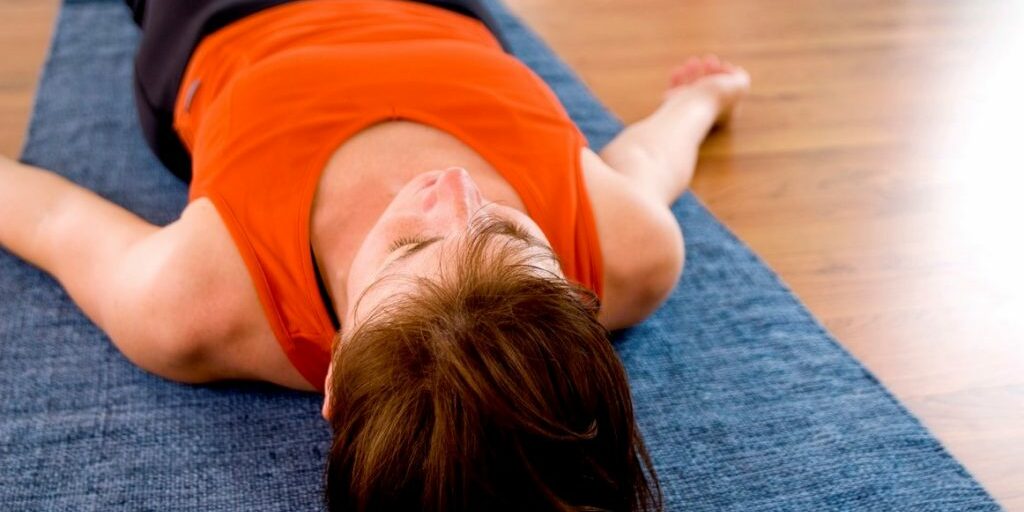Like our Yoga Expert, Natasha Rizopoulos, a vigorous/manic yoga practice is much more to my liking than a slooooooow stretchy kind of thing. I like to move on my mat, to feel I’m seriously accomplishing something. When I used to teach large yoga classes, I would so identify with women who looked although they were going to crawl out of their skin when I put them in Savasana (corpse pose) at the end of class. Now that I’m insanely busy, I’m realizing that this seemingly boring pose is arguably the most important pose of the lot. I asked Natasha to elaborate:
As a new Yoga student I remember being told that Savasana (Final Resting Posture) was considered one of the most important and difficult of the postures, and I distinctly recall rolling my eyes and thinking “Puleez, what’s so hard about lying down, I like lying down … Chaturanga is hard, Savasana, not so hard.”
But then I began making progress with Chaturanga and friends. And the more progress I made, the more excited and animated I got, and the more excited and animated I got, the less interest I had in Savasana.
So I would do a rigorous 2-hour Ashtanga practice, lie twitching and staring at the ceiling for a minute, and then jump up and head out into the world, as happy and wired as could be. And a few hours later crash precipitously and sleep walk through the rest of the day.
Finally my teacher made an intervention and announced that I wasn’t allowed to come out of the Ashtanga room until I had spent 10 minutes in Savasana with both my eyes and body covered.
Oh what a good and addictive thing that enforced Savasana turned out to be. For the next decade I took a 15-20 minute Savasana every time I practiced.
Of course this was facilitated by the environment, since in a Mysore-style Ashtanga room everyone practices and finishes at their own pace and can therefore take Savasana for as long as the room is open. There’s also something tremendously reassuring about dropping down encircled by the muted sounds of people murmuring, practicing, meditating and resting around you.
Then things changed (they always do, that’s the point) when I began practicing at home several years ago, and had to develop a whole new relationship with Savasana.
Absent the parameters and energy of the Yoga room, I would finish my asana practice and inexorably feel myself pulled to the computer, the phone, the refrigerator, whatever the next activity … You name it, it all seemed more urgent than lying on my mat with my eyes closed.
So I understand why students struggle with making time for Savasana and are tempted to skip it. And cannot emphasize strongly enough how crucial it is, especially as our lives grow increasingly frantic and scheduled.
We need Savasana because most of us desperately need time to be still and do nothing at all but breathe and notice. Time to settle down and get quiet without doing or producing anything. Even for 5 minutes.
What I’m describing is very different from lying in front of the TV in a semi-coma or going to sleep. This is about learning how to be completely relaxed and conscious; aware of what is happening around you but not engaged by it.
In Savasana we learn to let go, and also to observe from a calm, alert and pleasantly detached place.
This is a pretty handy skill, especially when you are more accustomed to operating at one or other end of the spectrum, either manic or torpid.
To use the language of Yoga, in Savasana we experience sattvha, the state of balance, clarity and lucidity, rather than the more typical seesawing back and forth between rajas and tamas (hyper-activity and lethargy) that tends to define how many of us would otherwise operate in the world.
Inhabiting this space on the Yoga mat then informs how you operate off the mat, providing a blueprint for walking a middle path that is present and alert, but not hectic.
So commit to Savasana. Get an eyebag (it will have a Pavlovian effect) and have a blanket or shawl handy whenever you practice so you can cover yourself and feel warm and protected. If you are at home set a timer so you can release deeply without fear of staying too long. If you are in a studio setting, don’t leave without taking Savasana (even if you need to wrap up early and lie quietly in a corner). When you flee without these minutes of quiet absorption you are missing the opportunity to bring everything that came before together.
 As for me, in my new practice setting I eventually learned to put out my eyebag and paschmina at the same time as my mat and props. If I had to go collect them at the end of my practice it was too easy to get sidetracked, but with them sitting beside me as I take a final twist or forward bend, the natural order is restored. As am I.
As for me, in my new practice setting I eventually learned to put out my eyebag and paschmina at the same time as my mat and props. If I had to go collect them at the end of my practice it was too easy to get sidetracked, but with them sitting beside me as I take a final twist or forward bend, the natural order is restored. As am I.
Go visit Natasha’s Site, to find out more about her amazing DVD’s, which I highly recommend for beginners or advanced yogi’s alike,




I feel relaxed by reading this post. You’re absolutely right about the importance of savasana. Thanks for the reminder. After a massage, I always want to lie on the table and relax a long time but I’m aware that the room will be needed for another fortunate person. When you do yoga at home, you can take as long as you want in savasana.